Results of TAKING STOCK assessment of Comoros underline challenges of transparency in fisheries management facing SIDS

The FiTI International Secretariat today published the findings of its 2022 TAKING STOCK assessment of Comoros, taking a deep dive into the types and quality of fisheries information that national authorities in the Indian Ocean archipelago are publishing on government websites.
The TAKING STOCK assessment considers the requirements of the FiTI Standard, the only internationally-recognised framework defining what fisheries management information governments should publish online. The transparency requirements of the FiTI Standard cover twelve thematic areas of fisheries management, ranging from fisheries laws and financial & catch data, to access agreements and the health of fish stocks. Transparency in fisheries management strengthens national authorities’ ability to manage the sector based on best available information, and is also a prerequisite for informed public debates, oversight and effective participation of all stakeholders in decision-making processes.
Overall, the assessment shows that while national authorities in Comoros publish some fisheries information online, a sizeable amount of what is requested under the FiTI Standard remains publicly inaccessible. Information corresponding to less than half of the transparency elements relevant to marine fisheries in Comoros can be found on government websites (16 of 34 applicable elements or 47%).
While the results clearly emphasise the need for improvements, it must also be recognised that online transparency efforts in fisheries management are often linked to the level of development of a country’s fisheries sector. For small island developing states (SIDS) such as Comoros, limited financial resources and human capacity constraints often result in national authorities prioritising more tangible policies in the fisheries sector over ensuring the online availability of government information. This is indeed true for Comoros – during the feedback period of this assessment, national authorities underlined that publishing information online has not been a part of government practice. Internet usage is low across the country, with the International Telecommunication Union estimating that only 8% of the population of Comoros uses the internet (according to 2017 figures). Appreciating these important contextual factors is a core principle of our TAKING STOCK assessments.
However, recent reforms in Comoros demonstrate that the government is seeking to move towards a system of e-governance, digitising its services and in doing so increasing public access to online information. These reforms include the introduction of the Stratégie Comores Numérique 2028 (Comoros Digital Strategy) in December 2018 and the establishment of the Agence Nationale de Développement du Numérique (National Agency for Digital Development) in January 2019. The role of digitisation as a lever of economic development is also highlighted in the Plan Comores Émergent 2020-2030 (Comoros Emerging Plan). This TAKING STOCK assessment therefore comes at an opportune moment, establishing a benchmark for fisheries transparency in Comoros from which national authorities can demonstrate improvements over time.
In addition to evaluating what is and is not published on government websites, the TAKING STOCK assessment also illustrates the quality of information published by Comorian national authorities – namely if it is freely accessible, up to date, and easy for people to find. These are all important factors to consider in terms of supporting public understanding around the current state of Comoros’ fisheries sector.
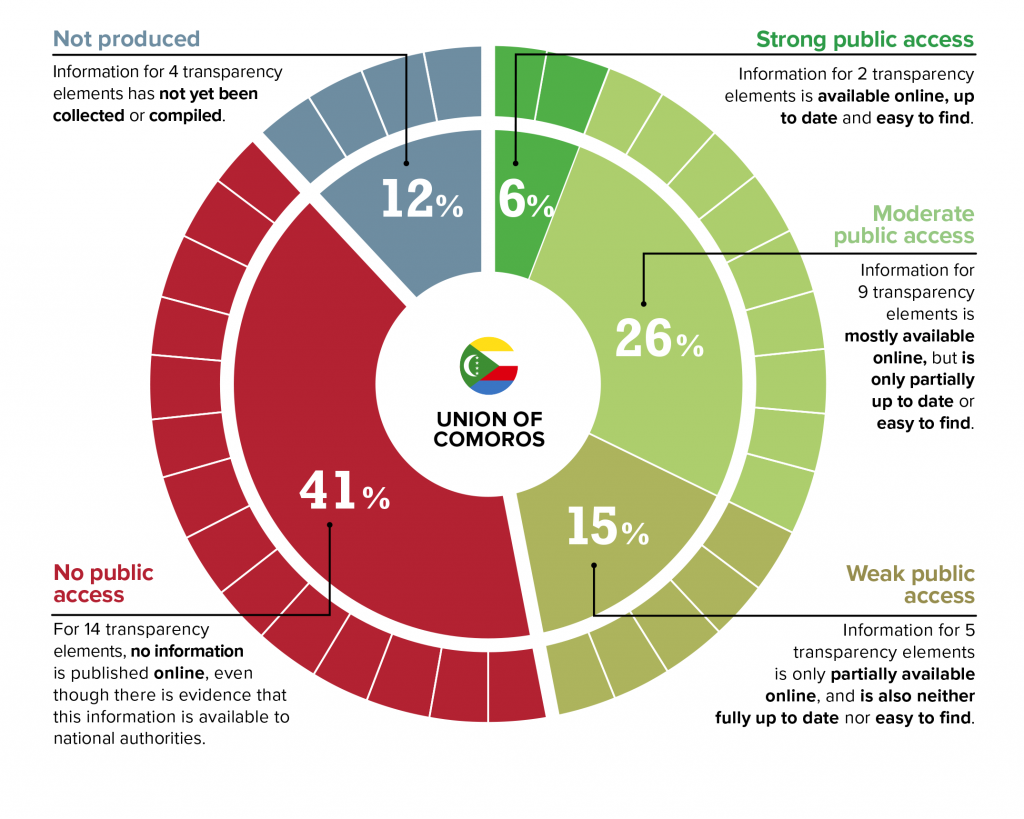
- Out of the 16 transparency elements for which information is published by Comorian authorities, only 13% fully meet the requirements of the FiTI Standard (i.e. the information is published, up to date and easy to find). Areas of fisheries management characterised by high levels of transparency include the artisanal sector and fisheries co-management agreements.
- Some fisheries information published by the government is well presented and therefore easy to find (i.e. mostly the information available on the website of the Direction Générale des Resources Halieutiques (DGRH), see below) but other information is hidden deep within the websites of government bodies with no immediate link to fisheries making it very likely interested stakeholders will fail to find it. In total, information for 56% of the 16 transparency elements can be easily found by a layperson.
- Again, certain fisheries information published by the government is updated regularly, most notably the artisanal data found in the annual Fisheries Statistical Bulletins. However, large amounts of information for other areas of fisheries management found over this assessment is outdated. In total, information for 56% of the 16 transparency elements is considered as up to date.
- No information is publicly accessible for 18 transparency elements, either because information that is available to national authorities has not been published online (14 elements), or the information has not been collected or compiled yet at all (4 elements). This lack of transparency permeates several important areas of fisheries management in Comoros, such as large-scale fishing activities in national waters, fisheries subsidies, law enforcement efforts and foreign fishing access agreements, among others.
According to Will May, FiTI’s Regional Coordinator for the Western Indian Ocean, ‘the results clearly confirm the precarious situation of SIDS like Comoros when it comes to online transparency efforts, many of which are highly dependent on donor financing. At the same time, while the FiTI emphasis ‘downward’ accountability’ – from the government to its citizens – we also need to recognise that countries have an important obligation to share information on a regional and global level as well.’ The FiTI international Secretariat will therefore continue its discussions with national authorities in Comoros on how to improve public access to fisheries information over time.
The findings of Comoros’ TAKING STOCK assessment are published in a Summary Assessment Report (in English and French), as well as an in-depth Detailed Assessment Report (in French).
Comoros’ assessment was funded by Irish Aid and carried out under the supervision and responsibility of the FiTI International Secretariat.

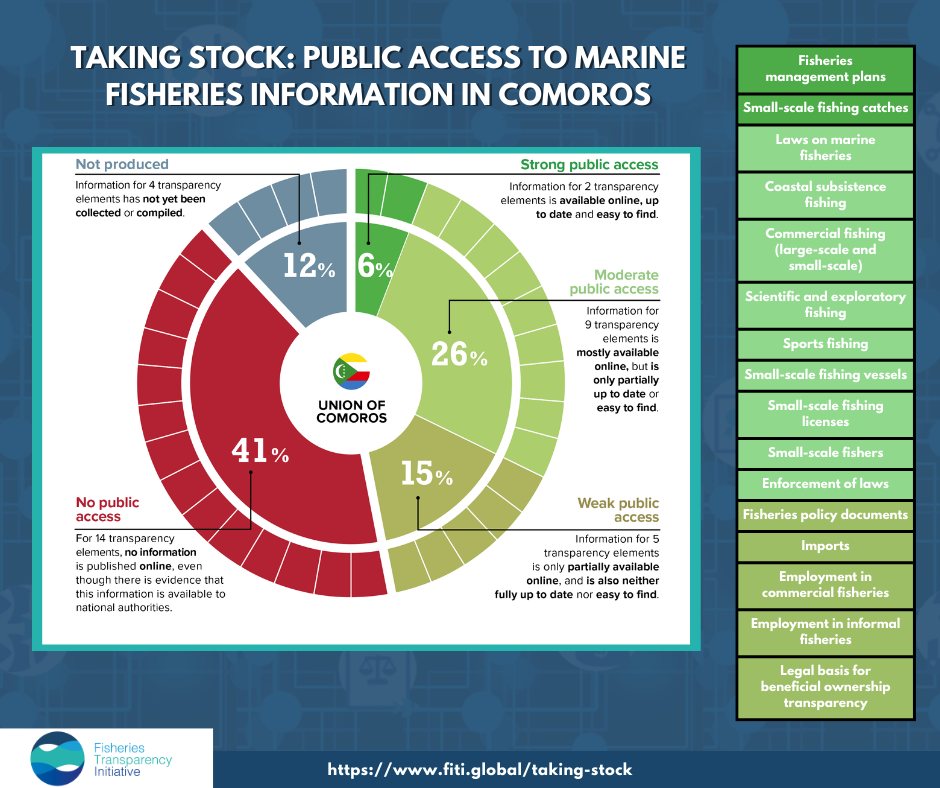
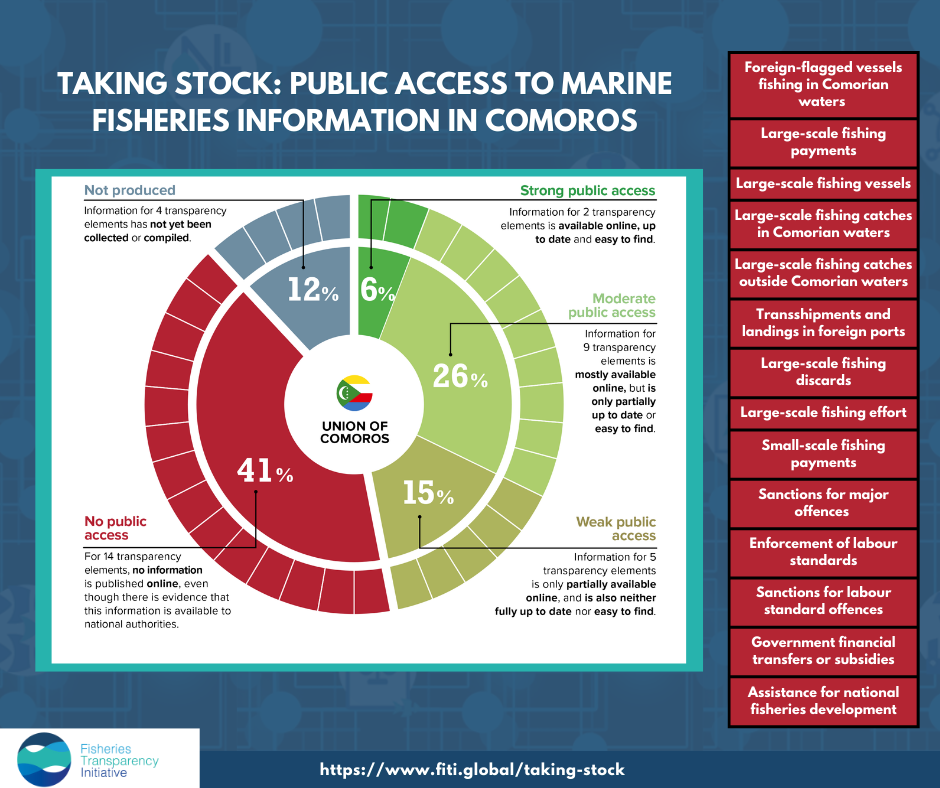
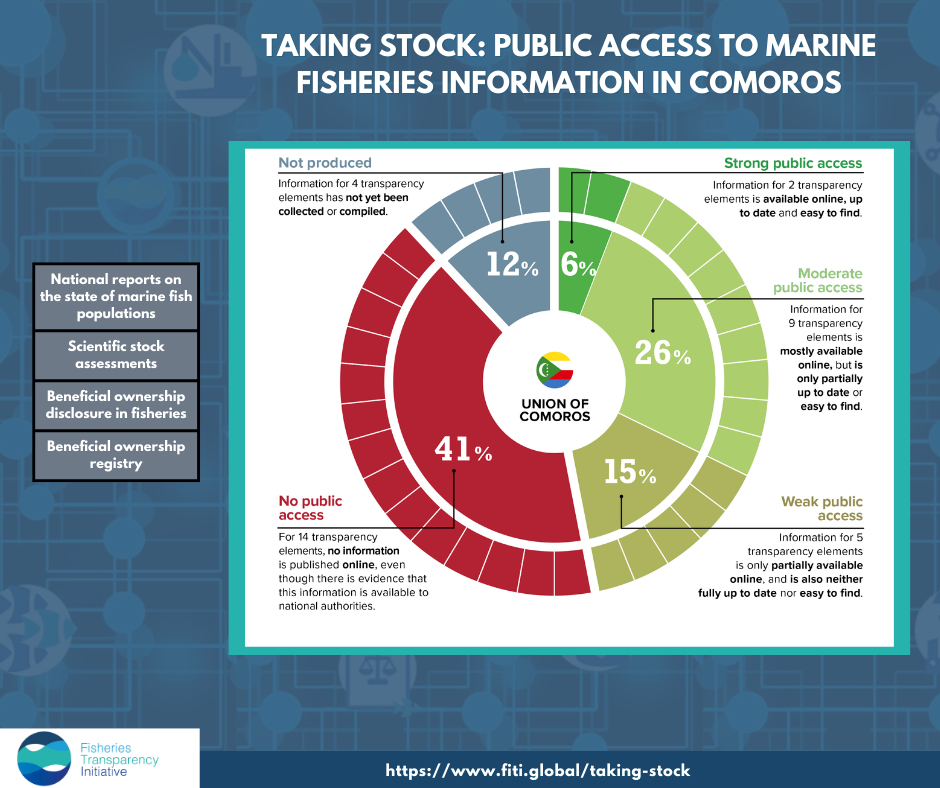
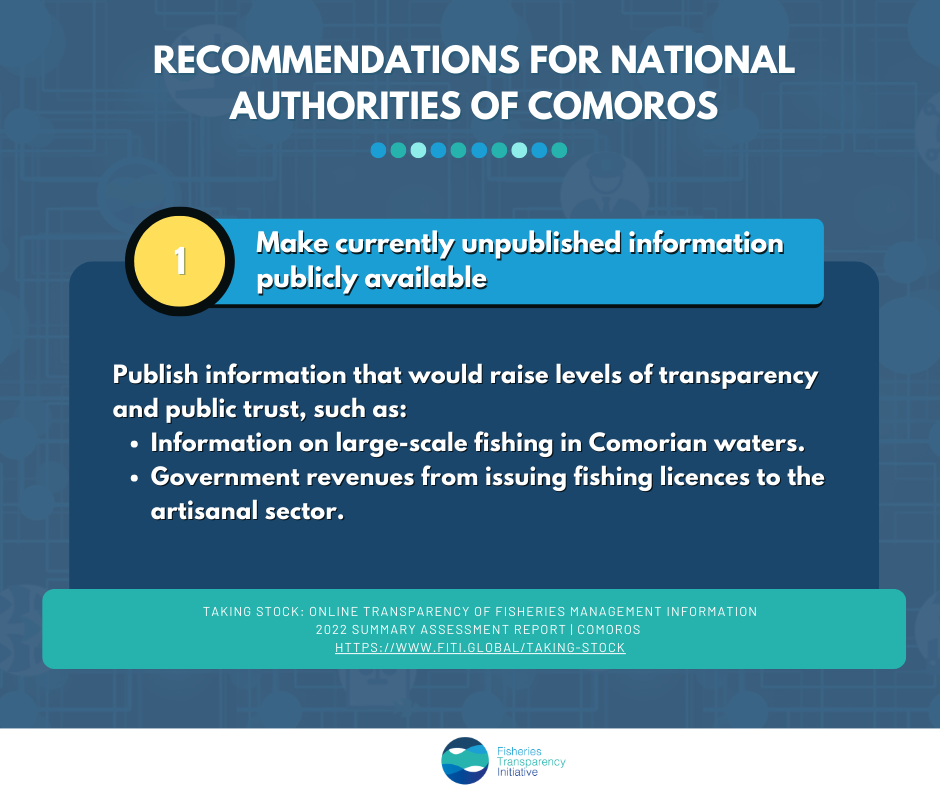
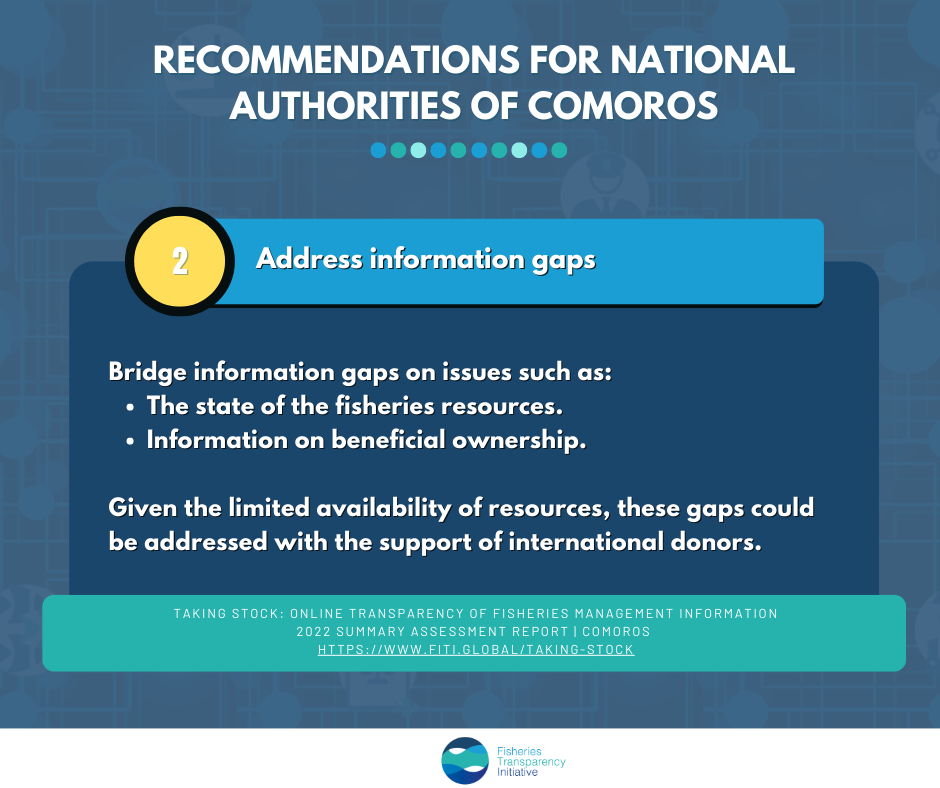

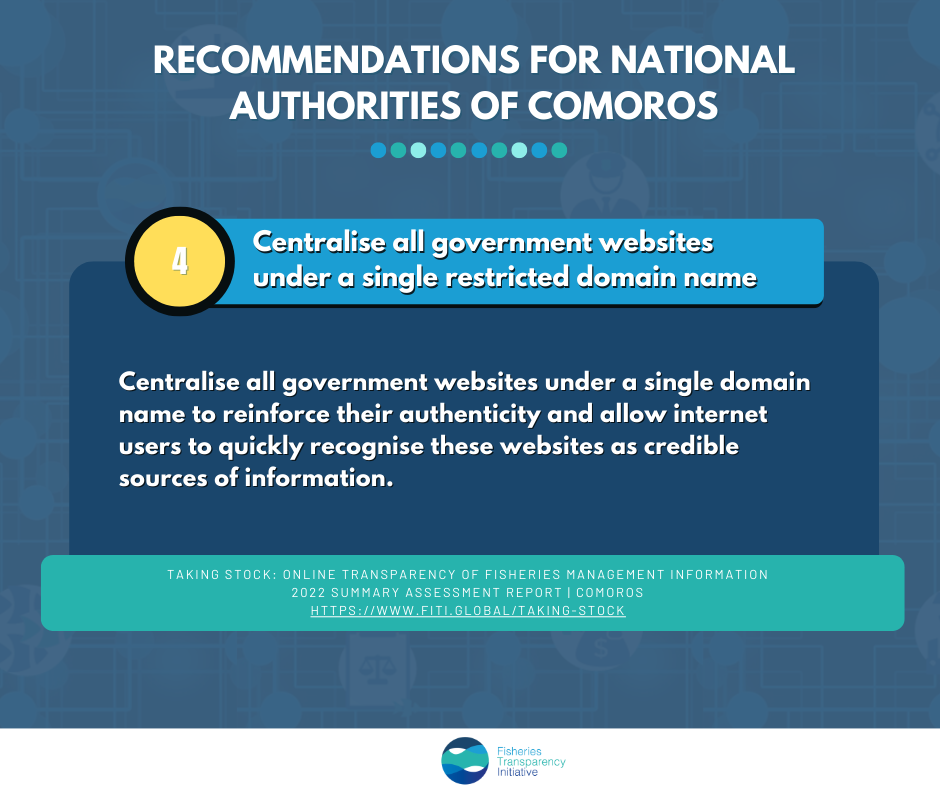
The principal portal through which the Comoros’ government publishes fisheries information online is the website of the Direction Générale des Resources Halieutiques (DGRH). This website hosts a fisheries dashboard that summarises key data on the sector and is also where the annual Fisheries Statistical Bulletins are published. These bulletins offer a detailed insight into Comoros’ artisanal fisheries sector, including important information like vessel numbers, catch data and fisheries production statistics. The website also included a registry of key legal and administrative texts, such as the Code des Pêches et de l’Aquaculture (2020), however this section was removed several days prior to the launch of this assessment. For this reason, some links in the assessment report may lead to defunct webpages.